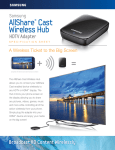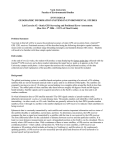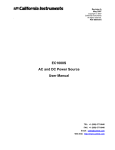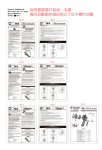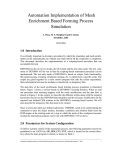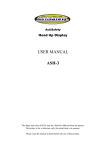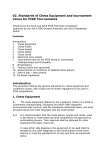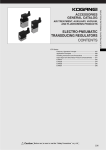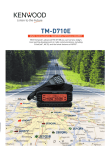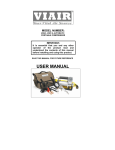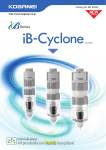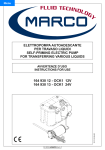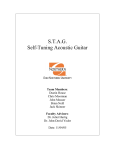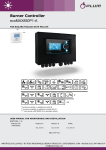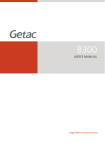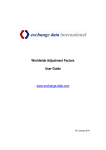Download Proportional Control Valves KFPV050 Series
Transcript
Catalog No.BKV0010 ISO 9001 / ISO 14001 Fluid Control Equipment Proportional Control Valves Series Environmentally friendly RoHS Compliant Product e t a R Flow ility Flexib Three Advanced Features! ●Stepless variable control of gases and liquids ●High-precision hysteresis (1/2 that of previous models) ●Initial setting possible without external input Fluid Control Equipment Proportional Control Valves Environmentally friendly Series RoHS compliant product! The Proportional Control Valves KFPV050 Series was developed on the basic concepts of high precision, efficiency, and simplicity. In combination with the KFPC1 dedicated controller, it enables stepless adjustment of flow rates by changing the magnitude of input signals to achieve high-precision control of air, gases, liquids, and various types of media. Proportional Control Valves w o Fl KFPV050 Series e t Rc1/4 Direct Acting 2-port Valve, Plunger type Ra ity Stepless variable control of gas and liquid flow rate! l i b i x e l F 2 High-precision specifications re 1 Featu ■ re Featu ■ In combination with the KFPC1 Controller, it achieves high performance of repeatability: 2% F.S. or less; response accuracy: 2% F.S. or less; and low hysteresis: 5% F.S. or less. ■ Wiring versatility Wiring can be installed freely in any direction to conform to machinery and device mounting conditions, enhancing design flexibility. 90 360 (Body material: SUS304) ● Possible wiring directions are every 90°, top to bottom, and right to left. ● The solenoid orientation can also be freely changed. Controller for Proportional Control Valve KFPC1 ■ With support circuits for initial setting! re 3 Featu Initial setting is possible without external input. ■ Highly reliable controller (Body material: Brass) q K ●Standard input signals of 4 to 20mA or 0 to 10V ●RAMP response time can be adjusted in a range from 0 to 10 seconds to relieve large fluctuations in the standard input signals. ●Monitor signals indicate the setting conditions and the solenoid current values. ●Zero point switch-off function ensures valves are completely closed. ●Built-in temperature compensation circuit ●Two potentiometers enable current value settings at which the valve starts to open and at which the valve is fully open to adapt application requirements. ●LED monitor indicator Caution Before use, be sure to read the “Safety Precautions” on p.K. p.e. Example of connection circuit configuration ●Solenoid SOL ●Solenoid SOL ●FG FG ●FG FG No polarity Proportional Control Valves KFPV050 Series To the frame ground ●Monitor voltage (+) SV+ Voltmeter, etc. + (mV) ●Monitor voltage (−) SV− − + 4 to 20mA, or 0 to 10V − ●Input signal (+) IN+ ●Input signal (−) IN− ●Power supply (+) 24V PLC, etc. ●Power supply (−) 0V + DC24V power supply − Controller for Proportional Control Valve KFPC1 Application Example (Controlling water flow) The KFPV050 Series changes the magnitude of the input signal to achieve stepless control of flow rates. This single control valve can cover what was previously done by using several conventional ON/OFF-type solenoid valves to control flow rates in a few steps. CONTENTS Safety Precautions . . . . . . . . . . . . . . . . . . . . . . . . . . . . . . . . . . . . e K Handling Instructions and Precautions . . . . . . . . . . . . . . . . . . . . t K Proportional Control Valves KFPV050 Series Symbol and Specifications . . . . . . . . . . . . . . . . . . . . . . . . . . . . . . u K Inner Construction, Major Parts and Materials, Order Codes . . . i K Dimensions . . . . . . . . . . . . . . . . . . . . . . . . . . . . . . . . . . . . . . . . . o K Controller for Proportional Control Valve KFPC1 Specifications, Major Parts and Functions, Order Code . . . . . . . !0 K Dimensions . . . . . . . . . . . . . . . . . . . . . . . . . . . . . . . . . . . . . . . . . . !1 K Flow Rate Conversion Graph . . . . . . . . . . . . . . . . . . . . . . . . . . . . !2 K Explanation of Terms . . . . . . . . . . . . . . . . . . . . . . . . . . . . . . . . . . !4 K w K Safety Precautions (Proportional Control Valves) Always read these precautions carefully before use. Before selecting and using the products, please read all the Safety Precautions carefully to ensure proper product use. The Safety Precautions shown below are to help you use the product safely and correctly, and to prevent injury or damage to you, other people, and assets beforehand. Follow the Safety Precautions for: ISO4414 (Pneumatic fluid power—Recommendations for the application of equipment to transmission and control systems), JIS B 8370 (Pneumatic system regulations) The directions are ranked according to degree of potential danger or damage: “DANGER!”, “WARNING!”, “CAUTION!”, and “ATTENTION!” DANGER Expresses situations that can be clearly predicted as dangerous. If the noted danger is not avoided, it could result in death or serious injury. It could also result in damage or destruction of assets. WARNING Expresses situations that, while not immediately dangerous, could become dangerous. If the noted danger is not avoided, it could result in death or serious injury. It could also result in damage or destruction of assets. CAUTION Expresses situations that, while not immediately dangerous, could become dangerous. If the noted danger is not avoided, it could result in light or semi-serious injury. It could also result in damage or destruction of assets. ATTENTION While there is little chance of injury, this content refers to points that should be observed for appropriate use of the product. ■This product was designed and manufactured as parts for use in General Industrial Machinery. ■ In the selection and handling of the equipment, the system designer or other person with fully adequate knowledge and experience should always read the Safety Precautions, Catalog, User’s Manual and other literature before commencing operation. Making mistakes in handling is dangerous. ■ After reading the Instruction Manual, Catalog, etc., always place them where they can be easily available for reference to users of this product. ■ If transferring or lending the product to another person, always attach the Instruction Manual, Catalog, etc., to the product where they are easily visible, to ensure that the new user can use the product safely and properly. ■ The danger, warning, and caution items listed under these “Safety Precautions” do not cover all possible cases. Read the Catalog and User’s Manual carefully, and always keep safety first. DANGER ● Do not use the product for the purposes listed below: 1. Medical equipment related to maintenance or management of human lives or bodies. 2. Mechanical devices or equipment designed for the purpose of moving or transporting people. 3. Critical safety components in mechanical devices. 4. Food and beverage feeder units, etc. This product has not been planned or designed for purposes that require advanced stages of safety. It could cause injury to human life. ● Do not use the product in locations with or near dangerous substances such as flammable or ignitable substances. This product is not explosion-proof. It could ignite or burst into flames. ● While the product is in operation, avoid touching it with your hands or otherwise approaching too close. In addition, do not make any adjustments to the interior or to the attached mechanisms (connecting and disconnecting of wiring connectors, piping tubes, or plugs) while in operation. It could result in abnormal operation leading to injury. ● When mounting the product and workpiece, always firmly support and secure them in place. Dropping or falling the product or improper operation could result in injury. ● Persons who use a pacemaker, etc., should keep a distance of at least one meter [3.28ft.] away from the proportional control valve. There is a possibility that the pacemaker will malfunction due to the strong magnet built into the product. ● Never attempt to remodel the product. It could result in abnormal operation leading to injury, etc. ● Never attempt inappropriate disassembly, assembly of the product relating to basic construction, or to its performance or functions. It could result in injury, electric shocks, fire, etc. ● Do not splash water on the product. Spraying it with water, washing it, or using it underwater could result in malfunction of the product leading to injury, electric shocks, fire, etc. WARNING ● Do not use the product in excess of its specification range. Such use could result in product breakdowns, function stop, erratic operation, or damage. ● Limit media to air, neutral gases, water, and other gases and liquids that do not cause damage to component parts. As the use e of other fluids risks rapid degradation of operating performance or a shorter operating life, be prepared to take responsibility for the use of such media. In particular, use of corrosive fluids can lead to stress corrosion cracks in the proportional control valve, resulting in injury, electrical shocks, fire, etc. ● Before supplying media or electricity to the device and before starting operation, always conduct a safety check of the area of machine operation. Unintentional supply of media or electricity could possibly result in electric shocks, or in injury caused by contact with moving portion. ● Always cut off the power when performing wiring work. Leaving the power on could result in electric shocks. ● Apply the specified voltage to the solenoid. Using the wrong voltage level will prevent the solenoid from performing its function, and could lead to breakage or burn damage of the product itself. ● Do not touch the terminal and the miscellaneous switches, etc., while the device is powered on. There is a possibility of electric shocks and abnormal operation. ● Avoid scratching the cords such as lead wires. Letting the cords be subject to scratching, excessive bending, pulling, rolling up, or being placed under heavy objects or squeezed between two objects, may result in current leaks or defective continuity that lead to fire, electric shocks, or abnormal operation. ● Do not pull out the connectors while the power is on. In addition, do not apply unnecessary stress on the connector. It could result in erroneous equipment operation that could lead to personal injury, equipment breakdown, or electrical shocks, etc. ● Always check the Catalog etc. to ensure that the product wiring and piping is done correctly. Errors in wiring and piping could lead to abnormal operation of the actuators, etc. ● In the first operation after the equipment has been idle for 48 hours or more, or has been in storage, there is a possibility that contacting parts have been stuck, resulting in equipment operation delays or sudden movements. For these first operations, always run a test operation before use to check that operating performance is normal. ● In low frequency use (more than 30 days between uses), there is a possibility that contacting parts may have become stuck, resulting in equipment operation delays or in sudden movements that could lead to personal injury. Run a test operation at least once every 30 days to confirm that movement is normal. ● Do not install the proportional control valves or the wiring that controls them, near power lines where large electrical currents are flowing, or in locations subject to strong magnetic fields or power surges. Such application could lead to unintended operation. ● The proportional control valve can generate surge voltage and electromagnetic waves when the device is turned off, affecting the operations of surrounding equipment. Use solenoids with surge suppression, or take countermeasures in the electrical circuits for surges and electromagnetic waves. ● Do not use the product where ozone may be generated, such as near ocean beaches or other places subject to direct sunlight or mercury lamps. Ozone can cause rubber parts to deteriorate, which can lead to degraded performance and functions, or to equipment stoppages and functional shutdown. ● Do not throw the product into fire. The product could explode and/or release toxic gases. ● Do not sit on the product, place your foot on it, or place other objects on it. Accidents such as falling and tripping over could result in injury. Dropping the product may result in injury, or also damage or break the product resulting in abnormal or erratic operation, or runaway etc. ● Repair work and maintenance, piping removal and installation, other parts replacement, and any other kind of work operation relating to the product, should be performed by a person or persons with adequate knowledge and experience with the product, media, fluid control systems, etc. Moreover, always completely shut off the supply of media, and observe the precautions listed below when performing these operations. 1. For gases, check that the pressure in the product and in the piping connected to the product is down to zero prior to work operations. In particular, be aware of the possibility of residual air in the air compressor and air storage tank. Residual pressure in the piping could cause the actuator to suddenly move, resulting in injury. 2. For liquids, drain all liquids from the product and piping. With corrosive fluids, in particular, there is a possibility of chemical burns or contamination of surrounding areas. 3. For high-temperature media, in addition to the above precautions, also check that the valve temperature has dropped sufficiently. Accidentally touching the hot surface could result in burn injuries. ● When it is necessary to keep the heat of the proportional control valve using an antifreezing heater or thermal insulation material, provide thermal insulation for pipes and the valve body only, and do not attempt to insulate the solenoid area. That could lead to coil burnout resulting in electric shocks, fire, or erratic operation. ● Use of the product under the conditions described below is subject to regulation under the Japanese High Pressure Gas Control Law. Be aware that violation of this law can result in penalties to individuals or corporations: Pressurized gases used at room temperature with gauge pressures of 1MPa [145psi.] or more, or pressurized gases capable of reaching pressures of 1MPa [145psi.] or more converted at a temperature of 35°C [95°F]. (Acetylene gas and liquefied gas are subject to even stricter standards.) For details, see the Japanese High Pressure Gas Control Law. ● When the proportional control valve is mounted inside a control panel or is continuously energized for long periods, take heat radiation measures to ensure that the ambient temperature of the proportional control valve always remains within the specified temperature range. In particular, caution should be exercised regarding the continuous energizing of a fully opened proportional control valve, because that could result in operational failure of the temperature compensation circuit used to stabilize the electrical current value against increased resistance when the solenoid temperature rises. ● When energized for long periods, the coil will become quite hot. Accidentally touching it could result in burn injuries. ● After finishing wiring operations, always check to ensure no wiring connection error before turning on the power. ● Design equipment systems so as to avoid equipment damage or personal injury, even in the event of operational failure of fluid control equipment due to an emergency stop, power outages, or other system abnormalities, such as an unintentional return to non-energized status. CAUTION ● Do not use the product in locations that are subject to direct sunlight (ultraviolet), dust, salt, iron powder, humidity and high temperature, or with the media and/or in the ambient atmosphere that include organic solvents, phosphoric ester type hydraulic oil, sulfur dioxide, chlorine gas, or acids, etc. It could lead to early shutdown of function or a sudden degradation of performance, and result in a reduced operating life. For the materials used, see Major Parts and Materials. ● When mounting the product, leave room for adequate working space around it. Failure to ensure adequate working space will make it more difficult to conduct daily inspections or maintenance, which could eventually lead to system shutdown or damage to the product. ● For mounting or transport of heavy products, use a lift, supporting tool, or several people, to provide firm support, and proceed with due caution to ensure personal safety. ● Do not bring floppy disks or magnetic media, etc., within one meter [3.28ft.] of the energized proportional control valve. There is a possibility that the data on the floppy disks will be destroyed due to the magnetism of the magnet. ● Do not use the proportional control valve in locations subject to large electrical currents or strong magnetic fields. It could result in erratic operation. ● Oil material from the compressor (excluding the oil-free compressor) can cause drastic deterioration in product performance that may lead to a functional shutdown. Always install a mist filter before pneumatic equipment to remove the oil material. ● If the media is a liquid, install a relief valve on the circuit to prevent it from being a liquid-closed circuit. There is a possibility that the valve may eventually fail to open. ATTENTION ● When considering the possibility of using this product in situations or environments not specifically noted in the Catalog or User’s Manual, or in applications where safety is an important requirement such as in an airplane facility, combustion equipment, leisure equipment, safety equipment and other places where human life or assets may be greatly affected, take adequate safety precautions such as an application with enough margins for ratings and performance or fail-safe measures. Be sure to consult us with such applications. ● Always check the Catalog and other reference materials for product wiring and piping. ● When handling the product, wear protective gloves and a mask, safety glasses, safety boots, etc. to keep safety. ● When the product can no longer be used, or is no longer necessary, dispose of it appropriately as industrial waste. ● Proportional control valves can exhibit degraded performance and function over its operating life. Always conduct daily inspections of the equipment, and confirm that all requisite system functions are satisfied, to prevent accidents from happening. ● Leaks from the proportional control valve are not zero. For application of requiring holding pressure inside the pressure vessel, consider adequate margin of capacity and holding time in design of the system. ● For inquiries about the product, consult your nearest Koganei sales office or Koganei overseas department. The address and telephone number is shown on the back cover of this catalog. OTHERS ● Always observe the following items. 1. When using this product in fluid control systems, always use genuine KOGANEI parts or compatible parts (recommended parts). When conducting maintenance and repairs, always use genuine KOGANEI parts or compatible parts (recommended parts). Always observe the required methods and procedure. 2. Do not attempt inappropriate disassembly or assembly of the product relating to basic construction, or its performance or functions. Koganei cannot be responsible if these items are not properly observed. r Handling Instructions and Precautions General precautions Mounting and piping Atmosphere 11. Mounting and piping should be performed by a person or persons with adequate knowledge and experience by using appropriate tools. 12. While any mounting direction is acceptable, the best direction is one that ensures the main body not being directly subjected to shocks or vibrations. Moreover, mounting so that the solenoid portion faces upward is recommended to prevent accumulation of foreign material, etc. 13. When connecting tubes to the Proportional Control Valve, flush the tubes completely (by blowing compressed air) before piping to prevent metal chips, sealing tape, rust, etc., generated during plumbing from entering inside the piping. 14. Mount a filter or a strainer near the proportional control valve to remove solid particles from the media. Accumulation of solid particles inside the proportional control valve could result in defective operation or damage to the proportional control valve. Use a filter or a strainer of about 80 to 120 mesh. 15. Take caution that the filter and strainer do not become clogged. When the pressure drop reaches 0.1MPa [14.5psi.], clean the strainer. 16. Check the direction of the fluid flow. 17. Use sealing tape to seal the piping connections. When using sealing tape, wrap it so that 1.5 to 2 threads remain (see below). ap e Wrapping direction S e a li n g t Rem ain abo ut 2 thre ads When screwing in piping or fittings, be careful to prevent thread shavings or sealant materials from entering inside the proportional control valve. 18. When tightening piping, be sure to hold the metallic parts of the main valve body. Do not apply any force to the solenoid plastic mold portion. Applying force there could cause damage to the solenoid. 19. When engaged in piping work, do not apply external force to the proportional control valve. Application of external force could cause damage to the proportional control valve. 10. When screwing piping or fittings into the proportional control valve, tighten to the appropriate tightening torque, as listed below. Connection thread Tightening torque N·m [ft·lbf] Rc1/4 11.77∼13.73 [8.68∼10.13] 11. Do not loosen or tighten the thread with the adhesive material used on the top of the proportional control valve. Such action could prevent normal operation of the proportional control valve. 12. When mounting the proportional control valve inside a control panel or when energizing it for long periods, consider providing heat radiation measures such as ventilation. t Avoid using the proportional control valve in the locations and environments listed below, as it could result in malfunction of the product. If use in such conditions is unavoidable, always provide a cover or other adequate protective measures. ● Location directly exposed to dripping water or oil ● Environment where the valve body is subjected to dew condensation ● Location directly exposed to metal chips, dust, etc. Storage For long-term storage after using water as a medium, be sure to completely remove any water remaining inside. Residual water could result in rust, defective operation, and deterioration of seal materials. Wiring instructions Solenoid 1. The solenoid can be moved freely to any orientation. Limit the tightening torque for the hexagon nut securing the solenoid in place to within the amount shown below. 1. Electrical connection: When using a DIN connector (KFPZ39), insert a gasket and connect it to the solenoid’s flat contacts. (Limit the cable length to 50m [164ft.] or less.) FG (Ground for valve) Hexagon nut SOL (No polarity) Can be moved freely to any orientation Model Tightening torque N·m [ft·lbf] KFPV050 2.8 [2.1] 2. While any mounting direction is acceptable, mounting so that the solenoid portion faces upward is recommended to prevent accumulation of foreign material, etc. SOL (No polarity) ● Avoid installing wiring parallel to high voltage lines or power lines, or within the same conduit. In addition, install wiring in locations as far removed from motors as possible. Installing in such locations can cause erratic operation. If installation near inductive loads or power lines is unavoidable, always take load surge suppression measures, and use magnetic shields. Use particular caution in environments that are subject to excessive external electrical noise, because of the high risk of erratic operation. 2. The tightening torque for the DIN connector mounting thread should be 0.3N·m [2.7in·lbf]. Precautions for Use 1. If planning to use any media other than the specified media, carefully consider the compatibility of that media with the valve body and seal materials, and be prepared to take responsibility for such use. ● Rising temperatures, increasing fluid densities, use of ultra-pure fluids, etc., risk hastening the rate of corrosion. ● For such use, always run sample tests beforehand to check compatibility with the media under actual application conditions. 2. The control characteristics will vary depending on the application and setting conditions. To use the valve, test the on-site control systems under actual application conditions, and fully perform checks for responsiveness, stability, effectiveness, and other characteristics. y Proportional Control Valves Series Rc1/4 Direct Acting 2-port Valve, Plunger type Use the proportional control valve in combination with the KFPC1 controller. For details of the controller, see p.!0. Symbol Basic Models and Functions Model KFPV050 Item Number of positions P A 2 positions Number of ports 2 ports Circuit configuration Normally closed (NC) Normally closed (NC) Common Specifications Basic model KFPV050 Item Media Note 1 Air, neutral gas, water (other gases and liquids that do not cause damage to component parts) FKM Seal material Brass or stainless steel Valve body material Media temperature range –10∼90 [14∼194] (no freezing allowed) °C [°F] Operation type Direct acting type Ambient temperature range °C [°F] 0∼55 [32∼131] 21×10– 6 [2.26×10– 4] or less m2/s [ft.2/sec.] Media viscosity Mounting direction Note 2 Any IP65 equivalent Environmental protection code Notes: 1. For the component part materials, see p.i, Inner Construction and Major Parts. 2. Mounting so that the solenoid portion faces upward is recommended to prevent accumulation of foreign material, etc. Detailed Specifications ● Seal Material: FKM Item Port size Models Orifice diameter Effective area Operating pressure differential range Maximum operating pressure mm2 MPa [psi.] MPa [psi.] Flow rate Cv mm [in.] KFPV050-2-20 Rc1/4 2.0 [0.079] 0.13 2.3 0∼0.7 [0∼102] KFPV050-2-30 Rc1/4 3.0 [0.118] 0.22 4.0 0∼0.35 [0∼51] KFPV050-2-40 Rc1/4 4.0 [0.157] 0.31 5.7 0∼0.2 [0∼29]0 Note: Allowable voltage fluctuation range: Rated voltage ±10% u 3.5 [508] Rated voltageNote DC24V Power consumption W 8 Coil current Mass MAX.: mA g [oz.] 300 550 [19.4] Inner Construction and Major Parts Parts No. !1 !0 o i u y t r e w OUT q IN Materials q Valve body w Plunger seal e O-ring r Guide tube t Plunger y Wear ring u Spring i Stopper SUS304 o Solenoid Polyester !0 Lock nut Free-cutting steel (nickel plated) !1 DIN connector Brass or SUS304 FKM FKM SUS304 Magnetic stainless steel PTFE SUS304 Plastic Characteristics ● Characteristics Curve Characteristics when used in combination with KFPC1 Controller Hysteresis %F.S. 5 or less Repeatability %F.S. 2 or less Response accuracy %F.S. 100% 2 or less 10:1 Range ability Cautions: 1. The characteristics curve at right shows the ratio of the measured flow rate (under Koganei test conditions) to the control signal input (electric current, voltage) with the maximum flow rate as 100% . 2. Since flow rate characteristics will vary depending on the application and setting conditions, check them under actual application conditions. Flow rate Remark: Measurement performed under Koganei measurement conditions. 0% 0% (0V) (4mA) 100% (10V) (20mA) Control signal input Proportional Control Valve Order Codes ■ Circuit ■ Orifice configuration diameter -2:2-port ■ Seal material -20:φ2.0mm -30:φ3.0mm -40:φ4.0mm -FM:FKM ■ Valve body material ■ Port size -BR:Brass -S4:SUS304 -02:Rc1/4 ■ Piping ■ Voltage specification -39:With DIN connector -39N:Without DIN connector DC24V Model -20 KFPV050 -2 -30 -FM -BR -S4 -02 -39 -39N DC24V -40 ●The Controller is sold separately; place a separate order for it. ● Order code for the connector only DIN connector standard type ( 27mm [1.06in.]) KFPZ-39 i Dimensions mm [in.] Proportional Control Valve KFPV050 IN 46 [1.811] Appliable cable outer diameter φ4 [0.157]∼φ11 [0.433] 71.8 [2.827] 2-Rc1/4 37.2 [1.465] 47.5 [1.870] 11 [0.433] OUT 83.7 [3.295] 43 [1.693] 33 [1.299] (53 [2.087]) 26.5 [1.043] 50.1 [1.972] 17 [0.669] (Width across flats) -39: D I N connector (-39 or to be ordered separate part KFPZ-39) 32 [1.260] 4.5 [0.177] 24 [0.945] 24 [0.945] 4-M4×0.7 Depth 7 [0.276] o Controller for Proportional Control Valve For Proportional Control Valves KFPV050 Series Specifications Model KFPC1-F07-DN DC24V Item Mounting type DIN rail mounting type 4∼20mA Signal input Ω Input impedance 0∼10V 220 Power supply voltage 1.2M DC24V±10% Valve control signal PWM (pulse width modulation) Ambient temperature range (atmosphere) °C [°F] 0∼50 [32∼122] (no condensation allowed) Maximum allowable load current A 1.1 Power consumption (for control circuit) W 0.55 Directly proportional to the solenoid current, 1mV = 1mA Monitor signal RAMP response time s 0∼10 Major Parts and Functions Potentiometer MAX Potentiometer MIN Connection terminals SOL POW MAX MAX MIN AUTO SOL FG MIN SW2 FG RAMP SV+ SV− IN+ IN− Slide switch SW2 Vertically in order from top MAX MIN AUTO ON 1 2 3 4 5 6 ON OFF Potentiometers MAX: For setting current value I2 at which the valve is fully open MIN: For setting current value I1 at which the valve starts to open RAMP: For setting RAMP response time (0 to 10s) Potentiometer RAMP LED indicator POW: Lights up when current is flowing to the solenoid DIP switch SW1 DIP switches SW1 1∼3 (SIGNAL): SW1 24V 0V Connection terminals SOL: Valve actuation output (no polarity) SOL: Valve actuation output (no polarity) FG: Ground for valve FG: Frame ground for power Monitor output (+) SV+: SV−: Monitor output (−) Standard signal input (+) IN+: Standard signal input (−) IN−: 24V: Power supply input (+) 0V: Power supply input (−) 4, 5 (PWM): 6 (ZERO): ● Order Code of the Controller for Proportional Control Valve Selects standard signal input (4 to 20mA, or 0 to 10V) Switches between PWM frequencies Sets the zero point switch-off function Slide switches SW2 MAX: Input signal MAX MIN: Input signal MIN AUTO: Input signal AUTO (operating mode) KFPC1-F07-DN DC24V !0 Dimensions mm [in.] Controller for Proportional Control Valve KFPC1-F07-DN MAX POW SOL MAX MIN AUTO FG FG 84.7 [3.335] 81 [3.189] SOL MIN RAMP SV+ SVON OFF IN+ IN- 1 2 3 4 5 6 24V SIGNAL PWM ZERO 0V 142942 (67 [2.64]) Remark: For Controller instructions , see the User’s Manual packaged with the product. !1 (60 [2.36]) (50 [1.97]) 30.2 [1.189] 41 [1.614] Flow Rate Conversion Graph (water, air) ● Water: Flow rate conversion graph 500 Cv5 100 Flow rate R/min 50 Cv1 Cv0.5 10 5 Cv0.1 Cv0.05 1 0.1 0.01 0.05 0.1 Pressure difference ΔP MPa 0.5 1 1R/min = 0.0353ft.3/min. 1MPa = 145psi. Remark: The pressure difference ΔP in the graph shows the pressure difference between the primary (upstream) gauge pressure P1 and secondary (downstream) gauge pressure P2. ΔP=P1−P2 (MPa) Flow rate equation (in the equation, pressures Ph and Pl show absolute pressure) Q=45.62Cv √ ̄  ̄ ̄ ̄ Ph−Pl √ ̄  ̄ G Q'=0.1338Cv '−Pl √ ̄  ̄ ̄' Ph ̄ √ ̄  ̄ G Q : Flow rate R/min Cv : Flow rate coefficient Ph : Primary (upstream) absolute pressure (Mpa) Pl : Secondary (downstream) absolute pressure (Mpa) G : Specific gravity (for water, this equals 1) Q' : Flow rate ft.3/min. Cv : Flow rate coefficient Ph' : Primary (upstream) absolute pressure (psi.) Pl' : Secondary (downstream) absolute pressure (psi.) G : Specific gravity (for water, this equals 1) How to use the graph When there is no diagram for the valve flow rate coefficient (Cv) in the above graph: Multiply the Cv of the valve being used by the flow rate at Cv = 1 read out from the graph to calculate the flow rate. Example: At Cv = 1, value read out from the graph: Q=20R/min [0.706ft.3/min.] for the desired pressure difference When the flow rate coefficient for the valve being used is Cv = 0.3 The flow rate is found by using the below equation Q×Cv=20×0.3=6.0R/min [0.212ft.3/min.] !2 Flow Rate Conversion Graph (water, air) ● Air: Flow rate conversion graph Cv = 1 Primary (upstream) pressure P1 (MPa) 2000 P1=1 P1=0.9 1500 P1=0.8 P1=0.7 Flow rate P1=0.6 P1=0.5 1000 P1=0.4 P1=0.3 P1=0.2 500 0 P1=0.1 0 0.1 0.2 0.3 0.4 0.5 0.6 0.7 0.8 0.9 1 Secondary (downstream) pressure P2 (MPa) 1R/min = 0.0353ft.3/min. 1MPa = 145psi. Remark: Pressures P1 and P2 in the graph show the gauge pressure (MPa). How to use the graph Flow rate equation (in the equation, pressures Ph and Pl show absolute pressure) 1) When Pl / Ph>0.5283 The above graph shows the flow rate when the flow rate coefficient Cv = 1. / 1, multiply the Cv of the valve being used by the When Cv= flow rate read out from the graph to calculate the flow rate. Q=4119Cv √  ̄ ̄ ̄ ̄ ̄ ̄ (Ph−Pl) Pl √ ̄  ̄ G 2) When Pl / Ph≦0.5283 Q=2056CvPh 1 √ ̄  ̄ G Example: Value read out from the graph: Q=500R/min [17.65ft.3/min.] (ANR) for the desired P1 and P2 When the flow rate coefficient for the valve being used is Cv=0.3 The flow rate is found by using the below equation Q×Cv=500×0.3=150R/min [5.30ft.3/min.] (ANR) Q : Flow rate R/min (ANR) Cv : Flow rate coefficient Ph : Primary (upstream) absolute pressure (Mpa) Pl : Secondary (downstream) absolute pressure (Mpa) G : Specific gravity (conversion specific gravity, when air is 1) 1) When Pl' / Ph' >0.5283 Q'=1.0Cv ') ̄ √ ̄  ̄'−Pl  ̄ ̄ ̄ ( Ph Pl' √ ̄  ̄ G 2) When Pl' / Ph' ≦0.5283 Q'=0.5CvPh' !3 1 √ ̄  ̄ G Q' : Flow rate ft.3/min. (ANR) Cv : Flow rate coefficient Ph' : Primary (upstream) absolute pressure (psi.) Pl' : Secondary (downstream) absolute pressure (psi.) G : Specific gravity (conversion specific gravity, when air is 1) Explanation of Terms ● Consumption power For direct current, this is the multiplied value of the product’s DC voltage and effective current value, and the unit used is W. ● Hysteresis A characteristic of equipment with different output values due to the directional applied input values. Output ● Cv A coefficient of flow rate, this is used to express a water flow rate in US gal/min when flowing through the valve at a pressure differential of 1lbf./in2 (1psi.) at a temperature of 60°F (15.5°C). Input ● Kinematic viscosity The viscosity of a fluid divided by the density of a fluid with identical conditions (temperature, pressure), as expressed . Represents the magnitude of resisin the formula tance when a liquid flows due to the action of its own mass. The most commonly used unit of kinematic viscosity is the cSt (centi-Stokes), which in SI units is m2/s (square meter per second). Another unit used is St (Stokes). For example, m 2/s (square meter per second) expresses the kinematic viscosity of a fluid for which the density is 1kg/m 3 and the viscosity is N S/m2 (Newton-seconds per square meter). A conversion table for each of these units is shown below. m2/s St cSt 1 1×104 1×106 1×10−4 1 1×102 1×10−6 1×10−2 1 ● Maximum operating pressure The maximum pressure to which the proportional control valve can be pressurized during operation. ● Operating pressure differential The difference between the inlet pressure and the outlet pressure, by which the proportional control valve can operate. ● Operating pressure differential range The range between the upper limit of the operating pressure differential (maximum operating pressure differential) and the lower limit (minimum operating pressure differential). ● Orifice diameter The narrowest part of the flow path inside the valve, with a relatively short length when compared to the cross-section dimensions. In other words, the cross-section area at the constricted location is converted into a circular cross-section area and then expressed as a diameter. ● PID control P action: Proportional action I action: Integral action D action: Derivative action This control consists of three control actions, including proportional action (P action); a control action in which the output of a control device is proportional to the input, integral action (I action) when output is proportional to the integration of input, and derivative action (D action) when output is proportional to the derivation of input. ( ) ● Pulse Width Modulation (PWM) When the frequency band is F [Hz], a signal is completely determined by the value of signal samples at 1/2F [S] (Sampling Theorem). Based on this theorem, all information from sampled modulation signals (such as voice, etc.) can be expressed in pulse rows, a technique known as pulse modulation. A number of methods are available. In pulse width modulation, one of these methods, a pulse width with a fixed amplitude, is used to change the amplitude information of samples in the sampled modulation signal. Voice and other modulation signals Sampled modulation signals Pulse width modulation ● RAMP response Time response when shifting input from a no-change state to a state in which change occurs at a fixed speed. ● RAMP response time In RAMP response, the time required for a value obtained by subtracting a first-order steady-state deviation of the output from the input multiplied by the static gain, falls within a specified tolerance range (for example, 5%). ● Range-ability A ratio between the maximum and minimum flow rate coefficients Cv in a controllable operation. For example, if the range-ability is 10 : 1, a valve with a maximum flow rate coefficient Cv of 10.0 has a minimum flow rate coefficient Cv of 1.0. ● Temperature compensation This is a characteristic of electronic parts. In general, changes in temperature or generation of heat can cause changes in the set electrical current and voltage levels, in a phenomenon known as temperature drift. An operation to compensate for this temperature drift is called temperature compensation. ● Viscosity Index expressing the degree of internal friction accompanying a fluid flow. Also known as absolute viscosity to distinguish it from kinematic viscosity. !4 Limited Warranty KOGANEI CORP. warrants its products to be free from defects in material and workmanship subject to the following provisions. Warranty Period Koganei Responsibility Limitations The warranty period is 180 days from the date of delivery. If a defect in material or workmanship is found during the warranty period, KOGANEI CORP. will replace any part proved defective under normal use free of charge and will provide the service necessary to replace such a part. • This warranty is in lieu of all other warranties, expressed or implied, and is limited to the original cost of the product and shall not include any transportation fee, the cost of installation or any liability for direct, indirect or consequential damage or delay resulting from the defects. • • • • KOGANEI CORP. shall in no way be liable or responsible for injuries or damage to persons or property arising out of the use or operation of the manufacturer’s product. This warranty shall be void if the engineered safety devices are removed, made inoperative or not periodically checked for proper functioning. Any operation beyond the rated capacity, any improper use or application, or any improper installation of the product, or any substitution upon it with parts not furnished or approved by KOGANEI CORP., shall void this warranty. This warranty covers only such items supplied by KOGANEI CORP. The products of other manufacturers are covered only by such warranties made by those original manufacturers, even though such items may have been included as the components. The specifications are subject to change without notice. URL http://www.koganei.co.jp E-mail: [email protected] OVERSEAS DEPARTMENT 3-11-28, Midori-cho, Koganei City, Tokyo 184-8533, Japan Tel: 042-383-7271 Fax: 042-383-7276 MICHIGAN REPRESENTATIVE OFFICE 5070 East N Ave., Kalamazoo, Michigan, 49048, U.S.A. Tel: 269-388-8769 Fax: 269-388-8771 SHANGHAI KOGANEI INTERNATIONAL TRADING CORPORATION Room 2606, 2607 Tongda Venture Building No. 1, Lane 600, Tianshan Road, Shanghai, 200051, China Tel: 021-6145-7313 Fax: 021-6145-7323 6/’06 30 BPBP ©KOGANEI CORP. PRINTED IN JAPAN RECYCLED PAPER

















